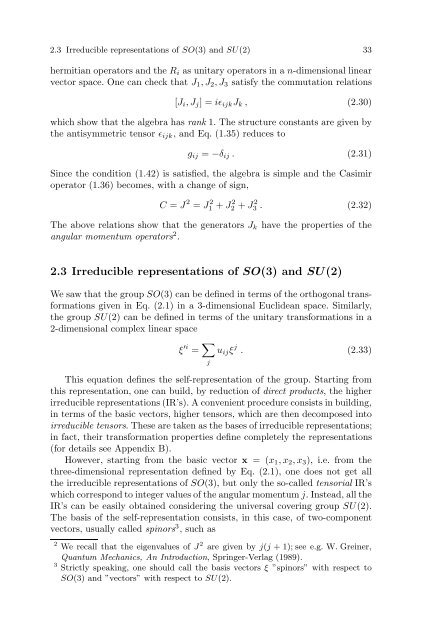Symmetries and Group Theory in Particle Physics: An Introduction to ...
Symmetries and Group Theory in Particle Physics: An Introduction to ...
Symmetries and Group Theory in Particle Physics: An Introduction to ...
You also want an ePaper? Increase the reach of your titles
YUMPU automatically turns print PDFs into web optimized ePapers that Google loves.
2.3 Irreducible representations of SO(3) <strong>and</strong> SU(2) 33<br />
hermitian opera<strong>to</strong>rs <strong>and</strong> the R i as unitary opera<strong>to</strong>rs <strong>in</strong> a n-dimensional l<strong>in</strong>ear<br />
vec<strong>to</strong>r space. One can check that J 1 , J 2 , J 3 satisfy the commutation relations<br />
[J i , J j ] = iǫ ijk J k , (2.30)<br />
which show that the algebra has rank 1. The structure constants are given by<br />
the antisymmetric tensor ǫ ijk , <strong>and</strong> Eq. (1.35) reduces <strong>to</strong><br />
g ij = −δ ij . (2.31)<br />
S<strong>in</strong>ce the condition (1.42) is satisfied, the algebra is simple <strong>and</strong> the Casimir<br />
opera<strong>to</strong>r (1.36) becomes, with a change of sign,<br />
C = J 2 = J 2 1 + J 2 2 + J 2 3 . (2.32)<br />
The above relations show that the genera<strong>to</strong>rs J k have the properties of the<br />
angular momentum opera<strong>to</strong>rs 2 .<br />
2.3 Irreducible representations of SO(3) <strong>and</strong> SU(2)<br />
We saw that the group SO(3) can be def<strong>in</strong>ed <strong>in</strong> terms of the orthogonal transformations<br />
given <strong>in</strong> Eq. (2.1) <strong>in</strong> a 3-dimensional Euclidean space. Similarly,<br />
the group SU(2) can be def<strong>in</strong>ed <strong>in</strong> terms of the unitary transformations <strong>in</strong> a<br />
2-dimensional complex l<strong>in</strong>ear space<br />
ξ ′i = ∑ j<br />
u ij ξ j . (2.33)<br />
This equation def<strong>in</strong>es the self-representation of the group. Start<strong>in</strong>g from<br />
this representation, one can build, by reduction of direct products, the higher<br />
irreducible representations (IR’s). A convenient procedure consists <strong>in</strong> build<strong>in</strong>g,<br />
<strong>in</strong> terms of the basic vec<strong>to</strong>rs, higher tensors, which are then decomposed <strong>in</strong><strong>to</strong><br />
irreducible tensors. These are taken as the bases of irreducible representations;<br />
<strong>in</strong> fact, their transformation properties def<strong>in</strong>e completely the representations<br />
(for details see Appendix B).<br />
However, start<strong>in</strong>g from the basic vec<strong>to</strong>r x = (x 1 , x 2 , x 3 ), i.e. from the<br />
three-dimensional representation def<strong>in</strong>ed by Eq. (2.1), one does not get all<br />
the irreducible representations of SO(3), but only the so-called tensorial IR’s<br />
which correspond <strong>to</strong> <strong>in</strong>teger values of the angular momentum j. Instead, all the<br />
IR’s can be easily obta<strong>in</strong>ed consider<strong>in</strong>g the universal cover<strong>in</strong>g group SU(2).<br />
The basis of the self-representation consists, <strong>in</strong> this case, of two-component<br />
vec<strong>to</strong>rs, usually called sp<strong>in</strong>ors 3 , such as<br />
2 We recall that the eigenvalues of J 2 are given by j(j + 1); see e.g. W. Gre<strong>in</strong>er,<br />
Quantum Mechanics, <strong>An</strong> <strong>Introduction</strong>, Spr<strong>in</strong>ger-Verlag (1989).<br />
3 Strictly speak<strong>in</strong>g, one should call the basis vec<strong>to</strong>rs ξ ”sp<strong>in</strong>ors” with respect <strong>to</strong><br />
SO(3) <strong>and</strong> ”vec<strong>to</strong>rs” with respect <strong>to</strong> SU(2).



![arXiv:1001.0993v1 [hep-ph] 6 Jan 2010](https://img.yumpu.com/51282177/1/190x245/arxiv10010993v1-hep-ph-6-jan-2010.jpg?quality=85)


![arXiv:1008.3907v2 [astro-ph.CO] 1 Nov 2011](https://img.yumpu.com/48909562/1/190x245/arxiv10083907v2-astro-phco-1-nov-2011.jpg?quality=85)








![arXiv:1002.4928v1 [gr-qc] 26 Feb 2010](https://img.yumpu.com/41209516/1/190x245/arxiv10024928v1-gr-qc-26-feb-2010.jpg?quality=85)
![arXiv:1206.2653v1 [astro-ph.CO] 12 Jun 2012](https://img.yumpu.com/39510078/1/190x245/arxiv12062653v1-astro-phco-12-jun-2012.jpg?quality=85)
